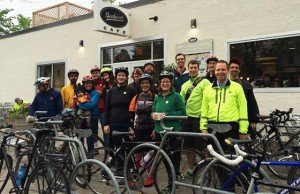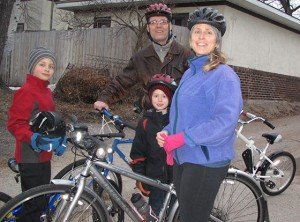Residents debate neighborhood issues as Minneapolis proposes constructing 30 miles of protected bike lanes by 2020
By TESHA M. CHRISTENSEN
 PHOTO: As part of Minneapolis Bike Week, Council Member Andrew Johnson (third from right, back row) and others biked to work on Fri., May 15. Minneapolis Bike Week 2015 was a series of events and activities promoting all types of bicycling with a focus on encouraging those who do not normally ride to give it a try. (Photo submitted)
PHOTO: As part of Minneapolis Bike Week, Council Member Andrew Johnson (third from right, back row) and others biked to work on Fri., May 15. Minneapolis Bike Week 2015 was a series of events and activities promoting all types of bicycling with a focus on encouraging those who do not normally ride to give it a try. (Photo submitted)
The biggest problem with the city’s bike lanes is that things are not predictable, according to local business owner Ella Ritzman of E’s Emporium (3911 Minnehaha Ave.).
“The addition of all of these different cycle paths with different layouts has made traffic more unpredictable than ever,” said Ritzman.
She added, “No one knows how they are supposed to interact with the new lanes.”
 PHOTO: Amy Brugh says she is an enthusiastic and confident biker when she’s alone, but interested and concerned when she’s biking with her children, ages 8 and 10. “My motto is regular people riding regular bikes with regular clothes on,” Brugh remarked. (Photo submitted)
PHOTO: Amy Brugh says she is an enthusiastic and confident biker when she’s alone, but interested and concerned when she’s biking with her children, ages 8 and 10. “My motto is regular people riding regular bikes with regular clothes on,” Brugh remarked. (Photo submitted)
Minneapolis Bike Coalition Board President Amy Brugh, who resides at 17th and 45th, understands the concerns people have about the lack of consistency regarding bike routes in Minneapolis.
She agrees that it makes intuitive sense to be consistent so that both bikers and drivers know what to expect. However, she thinks it is going to take time to achieve consistency.
Brugh pointed out that the city is trying to offer different types of bike routes for different types of riders. There are bike lanes along busy roads for strong and fearless riders (see end of the story for the definition of bike rider types). Bike boulevards are for enthusiastic and confident riders. And off-street paths, such as the Midtown Greenway and Minnehaha Creek trail, are for interested but concerned riders.
Less than 1% of city money goes towards bicycles
Right now, Minneapolis is putting the finishing touches on a plan to construct 30 miles of protected bikeways by 2020.
It will cost between $6.4 million and $11.6 million.
The cost of reconstructing a single mile of a major street for general traffic is estimated at more than $8 million.
Minneapolis Council Member Andrew Johnson (Ward 12) pointed out that less than 1% of transportation funding goes towards bicycle infrastructure despite making up nearly 5% of commutes/trips.
Others chipping in for bike routes within the city include Hennepin County (along county roads in the city) and the Minneapolis Parks and Recreation Board (on park land).
Are bike lanes being used?
Ritzman feels the city is over-building buffered bike lanes, and she doesn’t think they’re being used.
“We currently have more bike paths in our city than almost any other city in the country,” said Ritzman. “The Minneapolis Bike Coalition has said ‘if we build it, they will come.’” But Ritzman isn’t so sure that is true.
While the city is hoping that it can encourage its timid riders into biking more by creating protected bikeways she doesn’t think that it will help. Ritzman says it won’t change her riding habits.
“I, myself, don’t enjoy riding along paths with other bikers of various skills. It is stressful when I have to worry about who is coming up behind,” said Ritzman. “I much prefer to ride on a side street –– we have quite a few of these that run through the city.”
Ritzman doesn’t think that the existing bike lanes are being used by many riders.
“Since the addition of the bike lanes to Park and Portland I have not seen a mass of transit from bicyclists using these lanes,” said Ritzman. When driving for work on Nicollet between 36th and Lake St., she notices bikers are navigating between moving and parked cars, rather than using the buffered bike lanes one block on either side along Blaisdell and 1st.
She does appreciate the bike lanes on Minnehaha Ave., although she is concerned about how they will flow once pedestrian curb extensions are built during the reconstruction project.
Ritzman is glad that a cycle track isn’t going to be installed along Minnehaha as had been proposed.
“We don’t need cycle tracks. We need pedestrians, autos and cyclists to obey the rules of the road,” stated Ritzman.
Charlie Casserly agrees.
He bikes nearly every day along 28th Ave., and is looking forward to when the bike and walking pathways go underneath the street at Minnehaha Creek due to the bridge being reconstructed.
Casserly does not support bike lanes along 28th as he doesn’t think they are needed. “28th works well for bikes, cars and buses; it is a successful, multi-modal street,” he said.
He added, “Drivers do speed on 28th, but I think the best defense against speeders is a moving violation ticket. We need more police ticketing speeders.”
Does 38th St. need bike lanes?
Adam Weitzner lives on the River-Lake Greenway at 40th and Cedar, and while he sees bikers using the bike boulevard he doesn’t think it’s a good route because of the hills and stop signs along it.
He prefers to use 38th. “You can move quicker, and it is very wide, so there’s plenty of room for everyone to share the road – and it is better lit,” said Weitzner.
He’s not the only one who thinks that.
In fact, one of the main things expressed at the SENA Community Transportation meeting at Sibley Park on Apr. 30, is the desire to make 38th St. a designated bikeway.
A bikeway could mean a bike lane, street lighting, enhanced crossings, pedestrian-level lighting, and even additional landscaping to enhance the pedestrian realm. But a bikeway would likely also mean that some parking is removed.
Nothing will be done without more community meetings that involve businesses along that street, stressed Johnson.
He pointed out that bike lanes benefit local businesses because bicyclists are more likely to shop at local stores.
“There is a place for bike boulevards in addition to paths that are on the busier streets,” said Johnson. When making decisions, he asks: what do we want our community to look like?
“We need to make sure that we have an infrastructure that is working for everyone,” Johnson said.
Psychological studies that have been done showing that those who bike and walk are happier than those who drive, pointed out Johnson. “Not only are they healthier, but they are clinically proven to be happier,” said Johnson. “You can literally walk away depression.”
Is it redundant?
Weitzner isn’t the only one who has questioned the bike boulevard on 40th. Others believe it is redundant to have a bike boulevard on 40th and bike lanes two blocks south on 42nd.
This question points to the tension between different types of bikers, according to Brugh. Some want to take the quieter route and don’t mind traveling over a few blocks to find that.
However, others want the quickest and most direct way.
When it comes down to it, “bicyclists want to be able to ride where they want to go,” observed Brugh.
“It’s hard to tell people they shouldn’t be biking down a road they want to bike down,” agreed Johnson.
Brugh was pulled into the city’s discussion on bicycles in 2010 when her street was selected as the Southern Bike Connection. She pointed out that 17th Ave. lies two blocks from both Cedar and Bloomington, and it travels between Minnehaha Creek north to the Midtown Greenway.
The designated bicycle boulevard doesn’t have bike lanes. Instead, bikers use the street. Stop signs were removed to keep bikers moving, and miniature traffic circles (concrete circles with plants slow cars down) installed at intersections. A few installed medians, including the one at 17th and 42nd Ave., restricts left-hand turns for vehicles.
By the bike count numbers
According to last year’s one-day bicycle count, 40 people traveled along the Southern Bike Connection at its intersection just south of 42nd St. There were 60 people traveling along 42nd, and 150 on the River-Lake Bike Blvd. where it connects with the Southern Bike Connection (40th St. and 17th Ave.).
This compares to 250 bikers at 38th St. and Hiawatha Ave.; 150 on 28th St. just north of 42nd; 440 at 38th and Minnehaha Ave.; 260 on Hiawatha. just north of 42nd St.; 120 on 46th St. just west of Minnehaha Ave; and 1,080 on the park-maintained trail between Hiawatha and Nokomis lakes.
The top bicycling location in the city is Washington Ave. SE bridge, which had 7,370 bikers.
The city has been collecting data on the number of bicyclists since 2007. From 2007-2014, the number of bicyclists counted at 30 benchmark locations increased 73 percent.
Improvements that are coming
After listening to citizens at the community transportation meeting at Sibley Park, Johnson is hoping to help make some small changes that will add up to better experiences.
This summer, the crossing at Hiawatha Ave. and 38th will be improved, with green bike lane markings that direct where to go along with signal timing for pedestrians. Additionally, the stretch from Minnehaha west to Hiawatha will be smoothed, and bike lanes added.
Recognizing that all the Hiawatha east-west crossings could be improved, Johnson is also working to add markings that delineate where bikes and cars should go at 42nd and 46th, as well.
At the meeting, Johnson learned that many people in the area use 21st Ave. to connect with the Midtown Greenway, and residents are interested in that road being improved as a bikeway.
And residents pointed out that south of Minnehaha Parkway there is a complete absence of east/west bike infrastructure.
Goal: regular people riding bikes more
Brugh is an enthusiastic and confident biker when she’s alone, but interested and concerned when she’s biking with her children, ages 8 and 10.
“My motto is regular people riding regular bikes with regular clothes on,” Brugh remarked.
Brugh pointed out that she doesn’t demonize cars. “I’m a car driver, too,” she said. Brugh believes that cars will always be used in Minnesota, but she’d like to see a multi-modal system that increases public transit rides, bicycling and walking while decreasing the use of cars. And that, she added, will make streets less congested for the vehicles that are on the road.
“I hope that people see Minneapolis as a city where they can bike,” said Brugh, “and biking is something that feels like a normal option.”
Strong and fearless—defined by your bicycle, desiring to separate yourself more from pedestrians than vehicles, willing to bike anywhere in any weather? 1% of people
Enthusiastic and confident—comfortable sharing the road with vehicles but prefer bikeways and willing to go slightly out of your way for a better bikeway? 9% of people
Interested but concerned—prefer off-street paths for recreation and will ride for transportation where there are bikeways that make you feel safe. A good bike network might nudge you to be enthusiastic and confident, but a bad network will mean that you’re simply not interested. 53% of people
Not interested—no interest in biking for work or exercise, but do need to know the rules of the road for biking and driving. 35% of people
Comments
No comments on this item Please log in to comment by clicking here